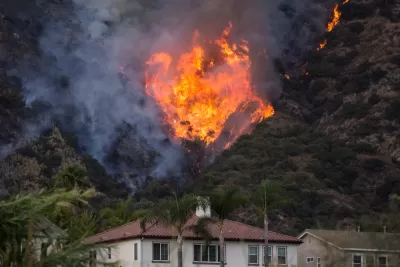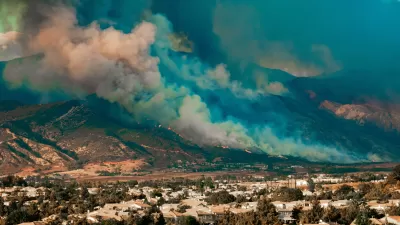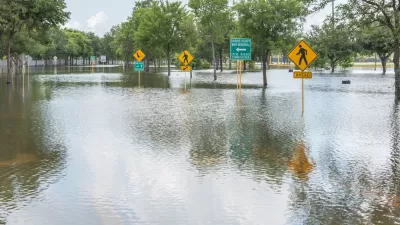Environmental risks are becoming too much for the home insurance industry to bear. Could this be the first signs of the collapse and reversal of sprawling land use patterns?

Los Angeles Times columnists Erika D. Smith and Anita Chabria write that California shouldn’t expect home insurers to stick around if the state continues to build in unsafe areas at constant risk for wildfires and extreme weather events.
“Our most vulnerable communities often lie in our most vulnerable regions: mountains marred by years of unprecedented wildfires, or Central Valley farm fields drowned in record rains and now epic snowmelt,” according to the column. The wake up call needed to reverse decades of sprawling development patterns, according to Smith and Chabria, might come from the home insurance industry.
According to previous coverage in the Los Angeles Times, State Farm General Insurance Co. announced recently that it would no longer accept new applications for property and casualty coverage in California because of wildfire and construction costs. Allstate Corp. also recently informed the state Department of Insurance that it stopped selling new home insurance policies last year. Allstate is also seeking a nearly 40% rate increase for home and business property and casualty insurance, according to the article.
Planetizen also picked up the news about insurers “fleeing” California, but it should be noted that insurers are also leaving Florida, where insurance premiums are already much higher than in California—and other states facing climate risks along coastlines or at wildland-urban interfaces shouldn’t expect to be spared the same drama forever.
According to the source article, linked below, California is still at risk of doubling down on sprawl, following years of historic housing legislation intended to spur new residential development.
“The problem is Newsom and his administration have required little oversight of where all this housing is being built. Nor have they communicated a cohesive philosophy about mitigating the current and future development risks linked to climate change,” write Smith and Chabria.
FULL STORY: Column: State Farm is right. California can’t keep building housing in high-risk places

Study: Maui’s Plan to Convert Vacation Rentals to Long-Term Housing Could Cause Nearly $1 Billion Economic Loss
The plan would reduce visitor accommodation by 25,% resulting in 1,900 jobs lost.

North Texas Transit Leaders Tout Benefits of TOD for Growing Region
At a summit focused on transit-oriented development, policymakers discussed how North Texas’ expanded light rail system can serve as a tool for economic growth.

Using Old Oil and Gas Wells for Green Energy Storage
Penn State researchers have found that repurposing abandoned oil and gas wells for geothermal-assisted compressed-air energy storage can boost efficiency, reduce environmental risks, and support clean energy and job transitions.

Santa Barbara Could Build Housing on County Land
County supervisors moved forward a proposal to build workforce housing on two county-owned parcels.

San Mateo Formally Opposes Freeway Project
The city council will send a letter to Caltrans urging the agency to reconsider a plan to expand the 101 through the city of San Mateo.

A Bronx Community Fights to Have its Voice Heard
After organizing and giving input for decades, the community around the Kingsbridge Armory might actually see it redeveloped — and they want to continue to have a say in how it goes.
Urban Design for Planners 1: Software Tools
This six-course series explores essential urban design concepts using open source software and equips planners with the tools they need to participate fully in the urban design process.
Planning for Universal Design
Learn the tools for implementing Universal Design in planning regulations.
Ascent Environmental
Borough of Carlisle
Institute for Housing and Urban Development Studies (IHS)
City of Grandview
Harvard GSD Executive Education
Toledo-Lucas County Plan Commissions
Salt Lake City
NYU Wagner Graduate School of Public Service





























